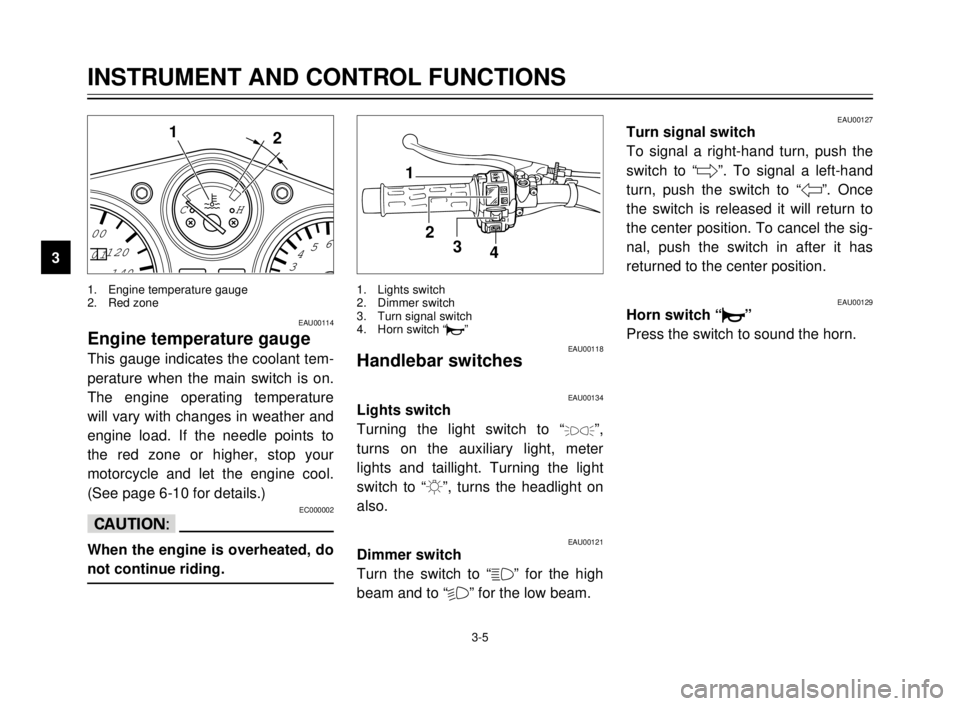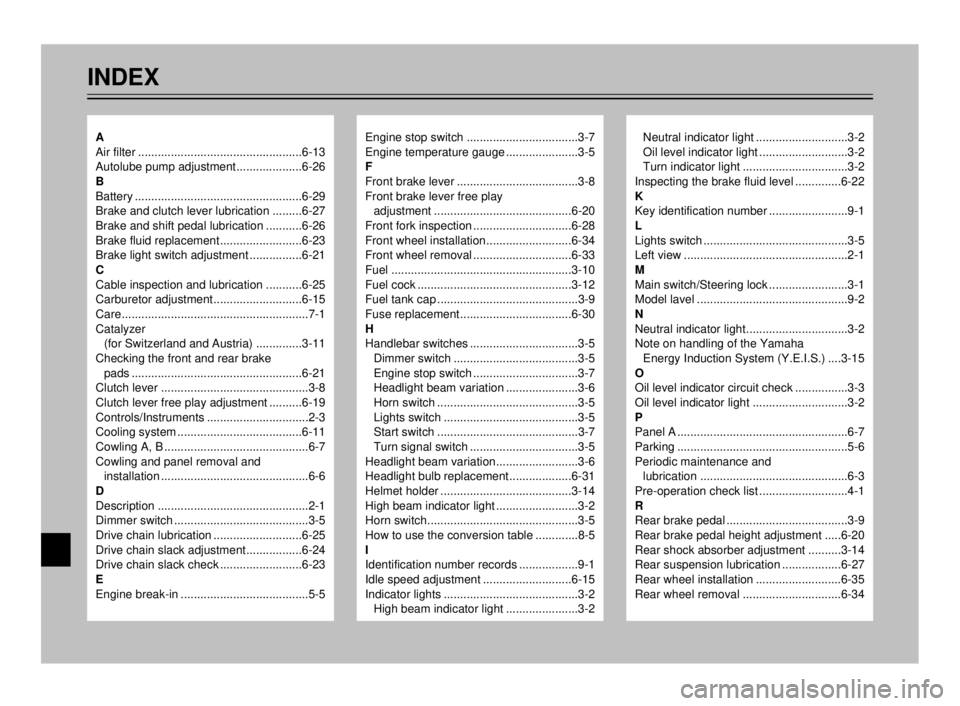2000 YAMAHA TDR 125 lights
[x] Cancel search: lightsPage 15 of 104

INSTRUMENT AND CONTROL FUNCTIONS
Main switch/steering lock........................................3-1
Indicator lights ........................................................3-2
Oil level indicator circuit check ...............................3-3
Speedometer ..........................................................3-4
Tachometer ............................................................3-4
Engine temperature gauge .....................................3-5
Handlebar switches ................................................3-5
Headlight beam variation ........................................3-6
Clutch lever.............................................................3-8
Shift pedal...............................................................3-8
Front brake lever ....................................................3-8
Rear brake pedal ....................................................3-9
Fuel tank cap ..........................................................3-9
Fuel.......................................................................3-10
Catalyzer (for Switzerland and Austria) ................3-11
Two-stroke engine oil ...........................................3-12
Fuel cock ..............................................................3-12
Starter (choke) “1” ..............................................3-13
Seat ......................................................................3-13
Helmet holder .......................................................3-14
Rear shock absorber adjustment..........................3-14
Note on handling of the Yamaha Energy
Induction System (Y.E.I.S.) ..................................3-15Y.P.V.S. (Yamaha Power Valve System) .............3-16
Sidestand..............................................................3-16
Sidestand/clutch switch operation check ..............3-17
3
5AE-9-E3 (ENG) 4/11/0 11:06 AM Page 13
Page 17 of 104

3-2
0
0
0100
01000140
180 120 100 80
1 2 3456
7
8
9
10
11
12
~1 000r/minkm/h
CH
12
43
EAU00056Indicator lights
EAU00057Turn indicator light “5 5
”
This indicator flashes when the turn
switch is moved to the left or right.
EAU00061Neutral indicator light “N”
This indicator comes on when the
transmission is in neutral.
EAU00063High beam indicator light “& &
”
This indicator comes on when the
headlight high beam is used.
EAU01313Oil level indicator light “7 7”
This indicator comes on when the oil
level is low. This light circuit can be
checked by the procedure on page
3-3.
EC000000
cC
Do not run the motorcycle until
you know it has sufficient engine
oil.
NOTE:
Even if the oil is filled to the specified
level, the indicator light may flicker
when riding on a slope or during sud-
den acceleration or deceleration, but
this is normal.
1. Turn indicator light “5”
2. High beam indicator light “&”
3. Neutral indicator light “N”
4. Oil level indicator light “
7”
INSTRUMENT AND CONTROL FUNCTIONS
1
2
3
4
5
6
7
8
9
5AE-9-E3 (ENG) 4/11/0 11:06 AM Page 15
Page 20 of 104

3-5
01
140 120 100
3456 CH
1
2
1. Engine temperature gauge
2. Red zone
EAU00114
Engine temperature gauge
This gauge indicates the coolant tem-
perature when the main switch is on.
The engine operating temperature
will vary with changes in weather and
engine load. If the needle points to
the red zone or higher, stop your
motorcycle and let the engine cool.
(See page 6-10 for details.)
EC000002
cC
When the engine is overheated, do
not continue riding.
INSTRUMENT AND CONTROL FUNCTIONS
1
2
3
4
5
6
7
8
9
1
2
3
4
EAU00118Handlebar switches
EAU00134Lights switch
Turning the light switch to “
'”,
turns on the auxiliary light, meter
lights and taillight. Turning the light
switch to “:”, turns the headlight on
also.
EAU00121Dimmer switch
Turn the switch to “&” for the high
beam and to “%” for the low beam.
EAU00127Turn signal switch
To signal a right-hand turn, push the
switch to “6”. To signal a left-hand
turn, push the switch to “4”. Once
the switch is released it will return to
the center position. To cancel the sig-
nal, push the switch in after it has
returned to the center position.
EAU00129Horn switch “* *
”
Press the switch to sound the horn.
1. Lights switch
2. Dimmer switch
3. Turn signal switch
4. Horn switch “*”
5AE-9-E3 (ENG) 4/11/0 11:06 AM Page 18
Page 35 of 104

4-2
PRE-OPERATION CHECKS
1
2
3
4
5
6
7
8
9
ITEM CHECKS PAGE
Brake and shift pedal shafts9Check for smooth operation.
6-28 9Lubricate if necessary.
Brake and clutch lever pivots9Check for smooth operation.
9Lubricate if necessary.
Sidestand pivot9Check for smooth operation.
6-28
9Lubricate if necessary.
Chassis fasteners9Make sure that all nuts, bolts, and screws are properly tightened.
—
9Tighten if necessary.
Fuel tank9Check fuel level.
3-9 ~ 3-10
9Fill with fuel if necessary.
Lights, signals and
9Check for proper operation. 6-32 ~ 6-34
switches
NOTE:
Pre-operation checks should be made each time the motorcycle is used. Such an inspection can be accomplished in a
very short time; and the added safety it assures is more than worth the time involved.
w
If any item in the Pre-Operation Check is not working properly, have it inspected and repaired before operating
the motorcycle.
5AE-9-E3 (ENG) 4/11/0 11:06 AM Page 33
Page 42 of 104

5-5
EAU00424
Tips for reducing fuel
consumption
Your motorcycle’s fuel consumption
depends to a large extent on your rid-
ing style. The following tips can help
reduce fuel consumption:
8Warm up the engine before rid-
ing.
8Turn off the starter (choke) as
soon as possible.
8Shift up swiftly and avoid high
engine speeds during accelera-
tion.
8Do not double-clutch or rev the
engine while shifting down and
avoid high engine speeds with
no load on the engine.
8Turn off the engine instead of let-
ting it idle for an extended length
of time, i.e. in traffic jams, at traf-
fic lights or railroad crossings.
EAU00436Engine break-in
There is never a more important peri-
od in the life of your motorcycle than
the period between zero and 1,000
km. For this reason we ask that you
carefully read the following material.
Because the engine is brand new,
you must not put an excessive load
on it for the first 1,000 km. The vari-
ous parts in the engine wear and pol-
ish themselves to the correct operat-
ing clearances. During this period,
prolonged full throttle operation, or
any condition which might result in
excessive heating of the engine,
must be avoided.
OPERATION AND IMPORTANT RIDING POINTS
1
2
3
4
5
6
7
8
9
EAU02937
Recommended shift points
(for Switzerland only)
The recommended shift points are
shown in the table below.
Acceleration shift point
km/h
1st ®2nd 20
2nd ®3rd 30
3rd ®4th 40
4th ®5th 50
5th ®6th 60
NOTE:
When shifting two gears down from
5th to 3rd, bring your motorcycle to a
speed of 35 km/h.
5AE-9-E3 (ENG) 4/11/0 11:06 AM Page 40
Page 87 of 104

1
2
3
4
5
6
7
8
9
7-2
8 8
Improper cleaning can damage
windshields, cowlings, panels
and other plastic parts. Use
only a soft, clean cloth or
sponge with mild detergent
and water to clean plastic.
8 8
Do not use any harsh chemical
products on plastic parts. Be
sure to avoid using cloths or
sponges which have been in
contact with strong or abra-
sive cleaning products, sol-
vent or thinner, fuel (gasoline),
rust removers or inhibitors,
brake fluid, antifreeze or elec-
trolyte.8 8
Do not use high-pressure
washers or steam-jet cleaners
since they cause water seep-
age and deterioration in the
following areas: seals (of
wheel bearings, swingarm
bearings, forks and brakes),
electric components (cou-
plers, connectors, instru-
ments, switches and lights),
breather hoses and vents.
8 8
For motorcycles equipped
with a windshield: Do not use
strong cleaners or hard
sponges as they will cause
dulling or scratching. Some
cleaning compounds for plas-
tic may leave scratches on the
windshield. Test the product
on a small hidden part of the
windshield to make sure they
do not leave any marks. If the
windshield is scratched, use a
quality plastic polishing com-
pound after washing.After riding in the rain, near the sea
or on salt-sprayed roads
Since sea salt or salt sprayed on the
roads in the winter are extremely cor-
rosive in combination with water,
carry out the following steps after
each ride in the rain, near the sea or
on salt-sprayed roads. (Salt sprayed
in the winter may remain on the roads
well into spring.)
1. Clean your motorcycle with cold
water and soap after the engine
has cooled down.
ECA00012
cC
Do not use warm water since it
increases the corrosive action of
the salt.
2. Be sure to apply a corrosion pro-
tection spray on all (even
chrome- and nickel-plated) metal
surfaces to prevent corrosion.
MOTORCYCLE CARE AND STORAGE
7
5AE-9-E3 (ENG) 4/11/0 11:06 AM Page 85
Page 100 of 104

INDEX
Engine stop switch ..................................3-7
Engine temperature gauge ......................3-5
F
Front brake lever .....................................3-8
Front brake lever free play
adjustment ..........................................6-20
Front fork inspection ..............................6-28
Front wheel installation..........................6-34
Front wheel removal ..............................6-33
Fuel .......................................................3-10
Fuel cock ...............................................3-12
Fuel tank cap ...........................................3-9
Fuse replacement..................................6-30
H
Handlebar switches .................................3-5
Dimmer switch ......................................3-5
Engine stop switch ................................3-7
Headlight beam variation ......................3-6
Horn switch ...........................................3-5
Lights switch .........................................3-5
Start switch ...........................................3-7
Turn signal switch .................................3-5
Headlight beam variation.........................3-6
Headlight bulb replacement...................6-31
Helmet holder ........................................3-14
High beam indicator light .........................3-2
Horn switch..............................................3-5
How to use the conversion table .............8-5
I
Identification number records ..................9-1
Idle speed adjustment ...........................6-15
Indicator lights .........................................3-2
High beam indicator light ......................3-2Neutral indicator light ............................3-2
Oil level indicator light ...........................3-2
Turn indicator light ................................3-2
Inspecting the brake fluid level ..............6-22
K
Key identification number ........................9-1
L
Lights switch ............................................3-5
Left view ..................................................2-1
M
Main switch/Steering lock ........................3-1
Model lavel ..............................................9-2
N
Neutral indicator light...............................3-2
Note on handling of the Yamaha
Energy Induction System (Y.E.I.S.) ....3-15
O
Oil level indicator circuit check ................3-3
Oil level indicator light .............................3-2
P
Panel A ....................................................6-7
Parking ....................................................5-6
Periodic maintenance and
lubrication .............................................6-3
Pre-operation check list ...........................4-1
R
Rear brake pedal .....................................3-9
Rear brake pedal height adjustment .....6-20
Rear shock absorber adjustment ..........3-14
Rear suspension lubrication ..................6-27
Rear wheel installation ..........................6-35
Rear wheel removal ..............................6-34A
Air filter ..................................................6-13
Autolube pump adjustment....................6-26
B
Battery ...................................................6-29
Brake and clutch lever lubrication .........6-27
Brake and shift pedal lubrication ...........6-26
Brake fluid replacement.........................6-23
Brake light switch adjustment ................6-21
C
Cable inspection and lubrication ...........6-25
Carburetor adjustment...........................6-15
Care.........................................................7-1
Catalyzer
(for Switzerland and Austria) ..............3-11
Checking the front and rear brake
pads ....................................................6-21
Clutch lever .............................................3-8
Clutch lever free play adjustment ..........6-19
Controls/Instruments ...............................2-3
Cooling system ......................................6-11
Cowling A, B ............................................6-7
Cowling and panel removal and
installation .............................................6-6
D
Description ..............................................2-1
Dimmer switch .........................................3-5
Drive chain lubrication ...........................6-25
Drive chain slack adjustment.................6-24
Drive chain slack check .........................6-23
E
Engine break-in .......................................5-5
5AE-9-E3 (ENG) 4/11/0 11:06 AM Page 98